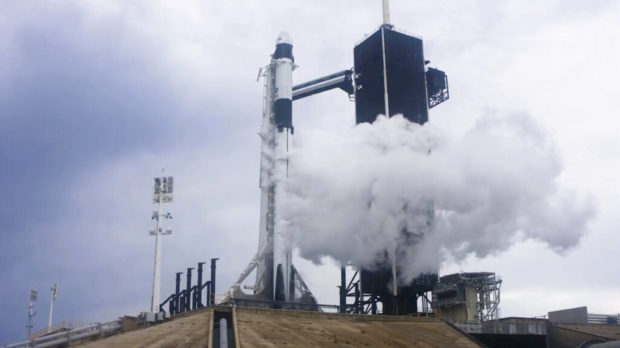
Liquid oxygen vents off the Falcon 9 rocket as NASA astronauts Bob Behnken and Doug Hurley in the Crew Dragon capsule prepare for launch from the Kennedy Space Center in Cape Canaveral, Florida, moments before the mission was aborted due to weather problems. (SpaceX via AP)
CAPE CANAVERAL, Florida — The launch of a SpaceX rocket ship with two NASA astronauts on a history-making flight into orbit was called off with less than 17 minutes to go in the countdown Wednesday because of thunderclouds and the risk of lightning.
Liftoff was rescheduled for Saturday afternoon.
The spacecraft — designed, built and owned by SpaceX — was set to blast off in the afternoon for the International Space Station, opening a new era in commercial spaceflight. It would have also marked the first time in nearly a decade that the U.S. launched astronauts into orbit from American soil.
But thunderstorms for much of the day threatened to force a postponement, and the word finally came down that the atmosphere was so electrically charged that the spacecraft was in danger of getting hit by lightning.
NASA Administrator Jim Bridenstine said the agency and SpaceX worked together to “make the right decision” and put safety first at a time when some were wondering whether the public attention surrounding the flight would create undue pressure to launch.
Veteran space shuttle astronauts Doug Hurley and Bob Behnken were supposed to ride into orbit aboard SpaceX’s sleek, white-and-black, bullet-shaped Dragon capsule on top of a Falcon 9 rocket, taking off from the same launch pad used during the Apollo moon missions a half-century ago.
Both President Donald Trump and Vice President Mike Pence had arrived to watch. Trump, who before the postponement marveled at the “magnificent” rocket on the pad, later tweeted that he will return to Florida for the next try, and the vice president did the same.
“Thank you to @NASA and @SpaceX for their hard work and leadership. Look forward to being back with you on Saturday!” Trump said.
The flight — the long-held dream of SpaceX founder Elon Musk — would have marked the first time a private company sent humans into orbit.
It would have also ended a launch drought for NASA. Ever since the space shuttle was retired in 2011, NASA has relied on Russian spaceships launched from Kazakhstan to take U.S. astronauts to and from the space station.
During the day, the rumble of thunder could be heard as the astronauts made their way to the pad at NASA’s Kennedy Space Center, and a tornado warning was issued moments after they climbed into their capsule.
“We could see some raindrops on the windows and just figured that whatever it was, was too close to the launch pad at the time we needed it not to be,” Hurley, the spacecraft commander, said after the flight was scrubbed. “Understand that everybody’s probably a little bit bummed out. That’s just part of the deal. … We’ll do it again, I think, on Saturday.”
“Appreciate your resilience sitting there in the vehicle,” a controller replied.
Behnken responded: “Nothing better than being prime crew on a new spaceship.”
The astronauts had to remain strapped in their seats until all the fuel in their rocket was unloaded and the emergency escape system was disarmed.
The launch preparations took place in the shadow of the coronavirus outbreak that has killed an estimated 100,000 Americans.
With this mission, “everybody can look up and say, ’Look, the future is so much brighter than the present.′ And I really hope that this is an inspiration to the world,” Bridenstine said.
The flight would put Musk and SpaceX in the same league as only three spacefaring countries — Russia, the U.S. and China, all of which have sent astronauts into orbit.
“What today is about is reigniting the dream of space and getting people fired up about the future,” Musk said in a NASA interview before the postponement.
A solemn-sounding Musk said he felt his responsibilities most heavily when he saw the astronauts’ wives and young sons just before the launch attempt. He said he told them: “We’ve done everything we can to make sure your dads come back OK.”
NASA pushed ahead with the preparations despite the viral outbreak but kept the guest list at Kennedy extremely limited and asked spectators to stay at home. Still, thousands jammed area bridges and beaches to watch, many of them not wearing masks or observing the 6-foot social distancing rules.
The space agency also estimated 1.7 million people were watching the launch preparations online.
Among the spectators was Erin Gatz, who came prepared for both rain and pandemic. Accompanied by her 14-year-old daughter and 12-year-old son, she brought face masks and a small tent.
She said the children had faint memories of watching in person one of the last shuttle launches almost a decade ago when they were preschoolers.
“I wanted them to see the flip side and get to see the next era of space travel,” said Gatz, who lives in Deltona, Florida. “It’s exciting and hopeful.”
NASA hired SpaceX and Boeing in 2014 to design and build spaceships to carry astronauts to the space station in a new kind of public-private partnership aimed at bringing down costs and spurring innovation. Boeing’s capsule, Starliner, is not expected to fly astronauts into space until early 2021.
Ultimately, NASA hopes to rely, in part, on its commercial partners as it works to send astronauts back to the moon in the next few years, and on to Mars in the 2030s.
“We’re doing it differently than we’ve ever done it before,” Bridenstine said. “We’re transforming how we do spaceflight in the future.”